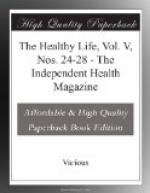each albumin. These deleterious formula of proteid
matter are not less suggestive than composition ones.
They reveal notable differences between “vegetal”
and animal albumins.
To be sure, animal albumins (beef, veal, mutton, pork, etc.) which we are offered in an alimentary flesh diet, resemble more nearly the structure of our own bodily albumins than do the gluten of bread or the albumin of vegetables. This fact seems actually the best support of the theory which affirms the superiority of the flesh over the vegetable diet. Such a remark is therefore well worth discussing by showing that the consequences which can be deduced from it are paradoxical, and rest upon hypothesis which, not very acceptable in theory, are hardly verified in practice.
Admitting that albumin plays in alimentary diet only the plastic part of reconstruction of used-up corporal matter, it might be advantageous to ingest but one albumin the composition of which is very similar to our own. By virtue of the law of least effort such a one in equal weights ought to be of more service than a foreign albumin, as it requires less organic work. For man, albumin of animal origin ought to be more profitable in equal weight than vegetable albumin. In the organism, indeed, albumin passes through a double labour. After the intestinal deterioration, followed by a passage through the digestive mucus membrane, a re-welding of the liberated acids takes place, with a formation of new albumin.
If, therefore, alimentary albumin’s mission is, not to be definitely burnt up in the organism, but to help in the plastication of the individual, the more its initial formula approaches the definite one to which it must attain, the more profitable it becomes, giving out less useless fragments and waste. Animal albumin approaching more nearly to human albumin, is also the one whose introduction into the daily alimentary diet is most rational. This statement seems to be the defeat of vegetal albumin. But let there be no mistake. It consecrates at the same time the triumph of anthropophagy, for there could not be for man a more profitable albumin than his own, or that of his fellow-man! This should make us pause and reflect, before allowing this deduction to be accepted.
Besides, these arguments ad hominem do not appear to us necessary for repelling such an interpretation of facts. Modern works have shown us that the greater proportion of ingested albumin played, in fact, a calorific, and not a plastic, part. Under these conditions one is justified in doubting whether there takes place with regard to the total albumins ingested a work of reconstruction thus complicated in the organism, after their first deterioration. Evidently one may come to believe that this complicated labour applies only to the more or less feeble portion of albumin really integrated.
Practically speaking, the best criterion




